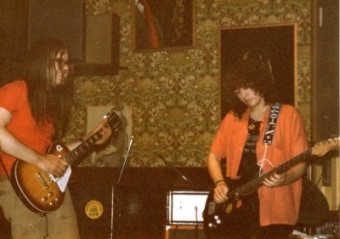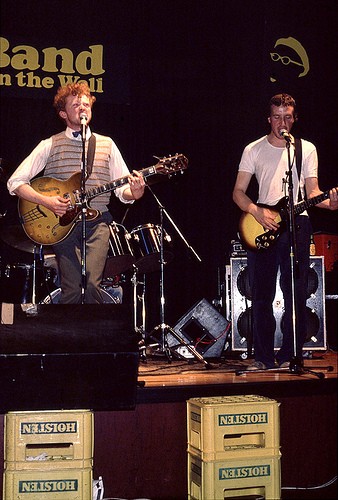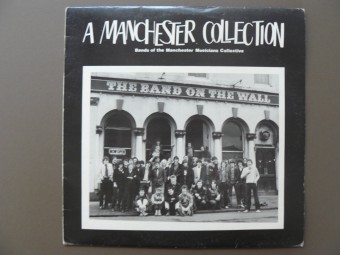Manchester Musicians Collective
Manchester Musicians Collective
70s Programme: Manchester Musicians Collective
When the idea of a Manchester Musicians Collective first emerged, it was expected that the participants would be from the exploratory end of the music spectrum, free improvisers perhaps and committed experimentalists, possibly mixing music with performance art. This expectation was based on the involvement with other collectives of the two original protagonists, music graduates Trevor Wishart and Dick Witts — Trevor in York, Dick in London. But soon after the Collective got going in April 1977 it was obvious that Manchester’s version would be very different: much more rock’n’roll.
We were shocked when rock-type bands turned up, looking to play. It was not what we had expected, — Louise Price (nee Alderman)(1).
At that time, Louise, aged 21, was a member of Dick Witts’s (2) contemporary ensemble the NorMedia Band that had recently performed compositions by Trevor Wishart – pieces that resembled happenings, including one that had Louise roaring on stage on a motor bike. Leather-clad in black, Louise and her motorbike – though not both on stage — would become constants at Collective events and she would soon be an operational centre-point and spokesperson for the Collective, as well as bass guitarist in The Manchester Mekon. Louise is now (2013) a maths lecturer.

Louise Price (right) (nee Alderman), bass guItar, and Frank Ewart, guitar, (left. Manchester Mekon at Band on the Wall, 1977.
In 1977 Trevor Wishart, with BA & Masters Degrees and a Doctorate behind him, was composer-in-residence at North West Arts Association and he organised the first meeting place for the Collective, the white-washed basement of the Association’s building in King Street. The basement, a twee restaurant during the day, would soon be bombarded with some remarkable sounds, including Trevor’s extraordinary vocalisations(3) and Manchester band The Fall’s raw, venomous first-ever gig. (4) The venue would soon prove too small for the Collective’s growing promotional aspirations.
North West Arts Association assisted in kick-starting the new Collective. The Association’s Annual Report for 1977/78 confirms the award of a grant of £410 to the Collective for rehearsal room hire and transport. This was perhaps the first time that NWAA had supported rock bands, although, given the more arty expectations of the instigators of the Collective, this may have been an unforeseen outcome. Much of the grant might also have returned to the Association via room hire.
Move to ‘The Band’
The Collective also met at the nearby Sawyer’s Arms on Deansgate to discuss the future. There, “the motley bunch of assorted musicians planned a flawed strategy to take over the world — starting with the gorgeously atmospheric venue, The Band On The Wall,” according to Collective member Mick Duffy (5) of the Blackburn band, IQ Zero. Duffy went on to become a northern correspondent of New Musical Express.
Sunday was the only available regular weekly night at Band on the Wall. By August 1976, the Sunday night gigs at the venue had ceased after a six-week run by the Bruce Rogers Trio and prior to that a longer-term residency by the Harry S Quintgroup, sometimes described as a jazz workshop. The Sunday nights were taken by the Collective on a trial basis and the first promotion took place on Sunday October 30; admission was 50p and – as would be the continuing format – there were three acts; on this first night these were poet Dominic Rivron, and bands, The Elite and On The Rocks. The trial promotions went well and included gigs by The Manchester Mekon, (November 6) and Trevor Wishart and The Fall (November 13). The Collective nights resumed in 1978, weekly on Sundays but switched to Tuesday nights from September of that year after the lengthy residency by Manchester jazz pianist Vinny Gorton’s Trio, plus guest soloists, came to an end.
Music critic and author Mick Middles described the venue and its adjacent area at that time: (6)
Over on the chip-paper’n’beer-can strewn streets of Ancoats, on Swan Street, stood the true downbeat musicianly heart of Manchester, Band on the Wall.
He described the Collective as
a motley and expanding gang of strummers and blowers, some immersed in studenthood, although most would scatter about the dole queues of Prestwich, Hulme and Stockport, music being their hope, their passion and, if only for an evening, their form of escape….
It was a curious mixture of insular musical meanderings and stark, half-formulated rock. Mick Hucknall’s Frantic Elevators** could often be found, noisily employing either the stage or the front row, as could Burnley’s hilarious Not Sensibles, the dull, hippyish Manchester Mekon, the Buzzcockian Fast Cars, Blackburn’s answer to Devo, IQ Zero and Joy Division. Joy Division enjoyed the Band on the Wall because it was a world away from the Manchester scene that – at least in their eyes – had so ostracised them.
**Hucknall went on to form Just Red, then Simply Red. His first band, Frantic Elevators, were members of the Collective and played at Band on the Wall several times, including on Collective nights, 18 June 1978 along with Dick Witts’s band The Passage, and on 14 November 1978, along with Fast Cars and The Manchester Mekon. His Just Red and Simply Red also played some of their first dates at the venue.

Frantic Elevators at Band on the Wall
In Praise of The Collective
At the time, Ian Curtis, troubled lead singer of Joy Division, was quick to praise the Collective, showing that experiment was indeed part of the ethos and not the preserve of the avant-garde: (7)
The Collective was a really good thing for Joy Division. It gave us somewhere to play, we met other musicians, talked, swapped ideas. Also it gave us a chance to experiment in front of an audience. We were allowed to take risks – the Collective isn’t about groups that need to draw an audience.
Others have since joined in, praising the innovative Collective on their website:
It was a very exciting time musically, the mix of musicians brought something to each camp giving everything an edge somehow previously lacking
The Collective changed the course of my life and I think also the lives of many others. With its DIY values and sexual inclusiveness it had an enormous influence on the Manchester music scene and of popular culture of the time with far reaching effects which have lasted until this day. – Louise Price
Andy White, Picture Chords:
My lasting image of what the Collective was originally will be that of people applauding some of the most unrehearsed bands without any words of criticism and only encouragement. Maybe this was because they knew that in the coming weeks it would be their turn.
Mick Duffy, IQ Zero:
Looking back, I think the Manchester Collective was a master-stroke of DIY home-made culture, an emblem of its time.
Aggro
The Collective started in the punk rock era that in the UK had raged and splattered into existence in 1976, particularly with The Clash and the Sex Pistols. Two gigs by the Sex Pistols at the Lesser Free Trade Hall in June and July of 1976 are cited by pundits as having a big influence on Manchester bands. For example:
There can be no denying that the whole modern Manchester music scene evolved from the Sex Pistols’ appearances during that long hot summer. – John Robb, ‘The North Will Rise Again’
The statement can be denied; there are many participants in the modern Manchester music scene, then and now, who would evolve without the Sex Pistols aid or influence. Indeed, as the stellar drummer/percussionist Dave Hassell would later affirm, there is not, one, Manchester music scene: there are many.
Video: In Conversation with Dave Hassell
Much of the Sex Pistols’ influence was behavioural or attitudinal, rather than musical, affecting audiences and bands (and writers and broadcasters). Violence erupted amongst the audience at the second of the Free Trade Hall concerts and was condemned by Johnny Rotten, leader of the Sex Pistols, yet it was The Pistols’ guitarist Steve Jones who famously summarised the band’s mission: “Actually, we’re not into music, we’re into chaos.” And chaos would have been a fair description of the scene at the Free Trade Hall when fighting broke out, allegedly between “the Slaughter and the Dogs lot and the Sex Pistols lot.”(8)
Ed Garrity was a roadie for the Wythenshawe group Slaughter & The Dogs — also on the bill that night — and ‘it all kicked off. I got hit on the head with a bottle. There was blood everywhere…. Someone said “there’s that headbanger with the nosebleed” and that’s where my name came from.” Garrity was a member of the band Wild Ram; thereafter it was renamed Ed Banger and the Nosebleeds.
For Garrity, his injury was a badge of initiation:
After spilling our blood for the punk cause, damn right we regarded ourselves as true punks. But we still got labelled bandwagon jumpers.(9)
The accounts of music gigs in Manchester around this time are littered with stories of violence, vandalism and (mostly) men behaving badly, for example:
At the Mayflower club, Gorton, in July 1979, Adam and the Ants
“played to a seriously antagonistic crowd who, though less than 50 in number, managed to smash every chair and every table into the band’s PA stack before the lone bouncer bundled them on to the pavement”. (10)
And now, the first line of the current (2013) website of Slaughter and the Dogs sounds almost like a macho boast, saying that they hail from “the notoriously tough Manchester suburb of Wythenshawe.”
Bands that played Band on the Wall in the 70s, such as Joy Division and Buzzcocks, had their moments of outrageous behaviour at other venues. Joy Division were in the support slot for the Buzzcocks tour in autumn 1979 and in a Glasgow hotel, “camaraderie boiled over into a veritable orgy of juvenilia, with a series of ‘dare games’ causing all band members to ‘hurtle’ around the corridors, banging on doors, crashing through chairs and sinking deeper and deeper into an alcoholic frenzy.”(11)
The closed hotel bar was raided, and police were called. “It was Richard Boon [Buzzcocks manager] who would bear most of the pain the next day, when the gargantuan bill was curtly handed to him.”
A few weeks later, according to Deborah Curtis – Ian Curtis’s wife – after their final tour date, at London’s Rainbow Theatre, Joy Division wrecked a toilet block in Guildford, “removing fluorescent light tubes and smearing the light switch and taps with excrement.”(12) But they did not behave that way when they played as Collective members at Band on the Wall.
Some band members of the Collective were intentionally intimidating. Stephen Murphy, of God’s Gift, said the band’s performances had a very belligerent, aggressive edge:
“Several gigs ended early due to angry customers or in random violence. The lyrics were always of paramount importance despite the extreme volume we played at. I think the aim was to be disruptive, aggressive, and intimidating whilst keeping up this seamless bombardment of sound. I believe it created a feeling of unease.”(13)
Good Vibes
But even if the occasional band, such as God’s Gift, sought to intimidate at Band on the Wall, all was mellow on the Collective nights.
There was always a good feeling. The bands supported one another, lent each other equipment; there was never any trouble. – Louise Price (14)
…it was a great atmosphere to make your first excursions into playing live and gave people the confidence to try out new ideas.
There always seemed to be a sense of excitement and expectation. I remember even feeling nervous for other bands playing since you tended to know most of the bands there. – Andy White, Picture Chords (15)
Musicians noted a distinct contrast between the atmosphere of the Collective nights and that of a number of the Factory gigs at The Russell Club, where from time to time there were squabbles between bands and fights in the audience, and unwelcome audience participation. John Bisset, of Spherical Objects, one of the Collective member bands:
Oh, and there was The Russell Club. We were supporting Howard Devoto’s post Buzzcocks band Magazine. A steady shower of spit bathed me throughout our set. (15)
The Factory nights at the Russell in Hulme started in 1978 and in the same year Factory Records was launched.
Though stopping short of spit, occasionally the audience at the Collective nights was abusive, though this was directed not at the stage but at a visiting member of the audience: special treatment was reserved for a TV presenter and Factory co-founder who, four years later would be a co-founder of The Hacienda Club:
Once or twice Tony Wilson turned up and got nothing but abuse from everyone –Steve Coogan’s portrayal of him [20th Century Party People] really was the most accurate. (16) – Andy White
The abuse hurled at Wilson may have been from band members who were aggrieved that he had not selected them to appear on one of the Granada TV programmes that he presented, nor invited them to join Factory Records artists’ roster. However, a performance at a Collective night at Band on the Wall could lead to a contract with Factory:
We signed to Factory early on, not long after I joined the band. Rob Gretton saw us play with Joy Division at the Manchester Musicians’ Collective and he told Tony Wilson about us. Tony Wilson put us on at the Factory to come and see us. (17) – Martin Moscrop, A Certain Ratio
And it was at Band on the Wall one night that the late Rob Gretton, Joy Division Manager, sitting at the back of the club and pondering the band’s recording future, scribbled on a beer mat his outline plan that would retain Joy Division with Factory Records, rather than sign with a major label. (18)
There is an instance elsewhere of the audience venting their anger towards the stage when a Collective band was playing. The short-lived band Picture Chords was persuaded by an organizer to do an encore after a particularly unpopular set at the Deeply Vale Festival, near Bury, Lancashire, in the late 70s:
“The problem was that we didn’t do encores and had nothing prepared so we made something up. The crowd’s reaction was not really positive and at one point I remember a whole potato narrowly missing me; why a potato was chosen to show their disgust I’ve no idea.”(19)
Had the incident been at Band on the Wall there would have been some symbolic, historical relevance to the potato. After all, Band on the Wall was formerly the George and Dragon market pub, and was surrounded by potato dealers. Indeed, the very stage and dance floor area of the club was formerly a fruit and veg stall and store, no doubt well stocked with potatoes.
A Collective Legacy
At Band on the Wall the promotions by the Collective lasted continuously for less than two years. Yet in that time, over 50 bands and individual performers took to the stage, some several times, some for the first time. A few had to borrow equipment from others, sometimes even instruments, in order to perform. As well as performing, many Collective members helped with the organisation, publicity and presentation of the events. There was, yes, a collective spirit.
In an era when the macho posturing of some bands could be accompanied by mayhem in the stalls or on the dance-floor, the Collective promotions were remarkably well-behaved affairs. This perhaps was the result of the cooperative ethos and demeanor of the organisers and the calming influence and mature reputation of Band on the Wall and its management, with its genial boss, Steve Morris.
A few of the participants, such as Mick Hucknall, went on to fame and fortune. For some others the experience was life-changing in other ways, giving them confidence to pursue careers or hobbies, in music or in other fields. More than 30 years on, many of the musicians of the Collective are still writing, recording and playing in bands.
On Record
The first Collective album, ‘A Manchester Collection.’ was released in 1979. This was on Object Music, the record label of Steve Solamar, of Spherical Objects, who chose the line-up for the album. The second album. ‘Unzipping The Abstract.’ was released in 1980, on the Collective’s own label.

“A Manchester Collection” Bands of the Manchester Musicians Collective. Cover Photo by Kevin Cummins.






